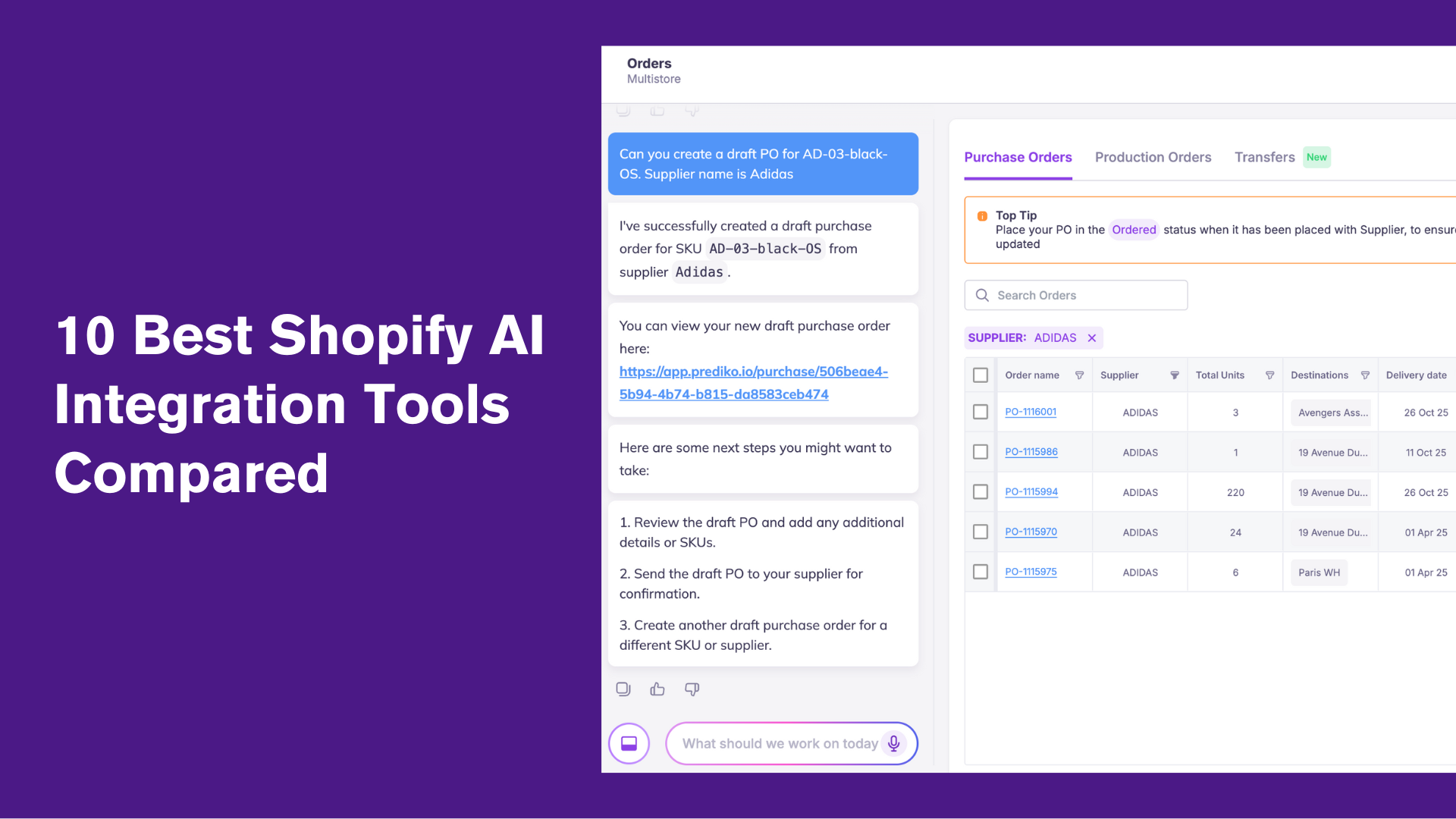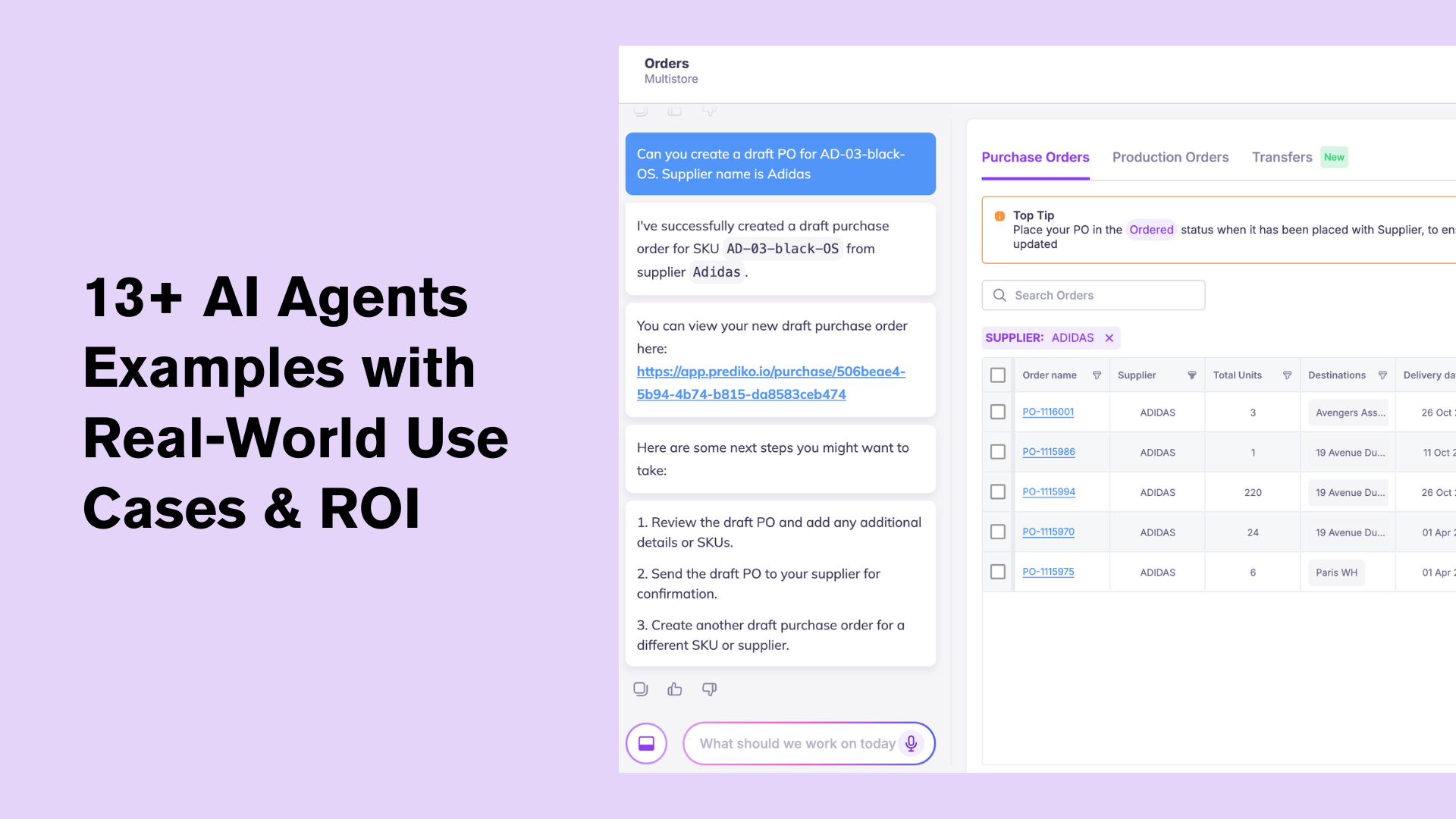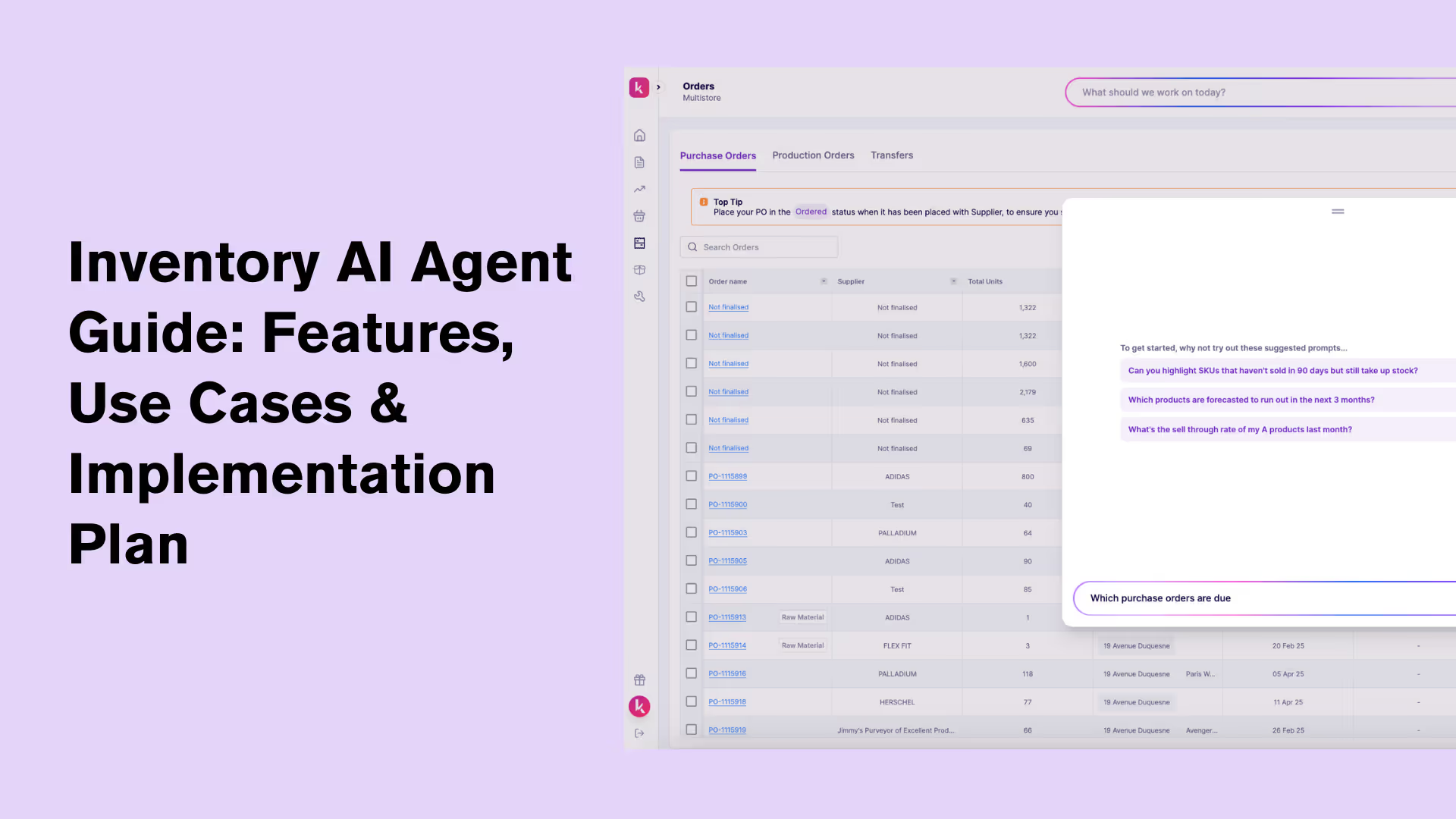Starter Plan 🚀
Prediko's AI forecasting is now available from $49/month. Plan for 2026.
Why Prediko?
Resources
How it works
Book Demo
Pricing

Imagine this - you get alerted of a spike in sales before it happens, your system knows about a restock before inventory hits zero, and your replenishment plan adjusts itself for promotions while you sleep.
That’s not magic. That’s AI in inventory management.
Forget juggling spreadsheets, chasing last year’s data, or reacting too late. AI doesn’t just automate, it anticipates. It gives your inventory a brain; one that learns, adapts, and stays 10 steps ahead.
We break down how to use AI in inventory management, why current setups fail, how to implement AI, and the AI inventory use cases worth trying.
Inventory needs shift constantly in response to customer demand. Traditional processes can’t keep up, and that’s exactly where the gaps begin.
Here’s why old methods fall short and what it’s costing your business.
Traditional inventory systems depend on manual activities for stock updates, purchase orders, and reporting. These workflows are slow and often fail to keep up with fluctuating demand and supply disruptions.
Manual tracking makes it harder to maintain visibility across multiple locations. This way, errors in recording stock movements or delays in updates can create mismatches between actual and recorded inventory.
Over time, these issues cause delays in replenishment, increase costs (storage, expedited shipping, markdowns), and limit the ability to respond to demand spikes or supply chain interruptions.
Spreadsheets are where most businesses begin their inventory management journey. They’re low-cost and easy to use, but they come with serious limitations.
Accuracy depends on frequent manual updates and strict version control, which is hard to maintain in fast-moving environments.
Even small errors, like broken formulae, an outdated entry, or a duplicate record, can create major discrepancies in stock levels.
And when teams work across multiple files, data becomes fragmented, and real-time visibility disappears.
The result? Poor decisions, overstocking in some areas, stockouts in others, and ultimately, lower service levels and higher carrying costs.
Human involvement in inventory management introduces risks of miscounts, wrong SKU entries, and delays in processing orders. These errors are magnified in high-volume operations or businesses managing complex product lines.
Without automated checks, mistakes during stock counts or receiving can slip through unnoticed until they cause overstocks or stockouts, leading to fulfilment issues.
In short, manual reconciliation takes time and still leaves room for inaccuracies.
These gaps then affect order accuracy, increase customer complaints, and often require emergency shipments or safety stock that raise operational expenses.
Legacy systems and spreadsheets lack real-time visibility into inventory records.
Without timely and accurate data, teams are forced to delay critical decisions like adjusting purchase orders or transferring stock between locations.
This slows down responses to demand spikes or supply disruptions, compounding the financial impact.
Over time, these delays shrink margins and make it harder for businesses to stay competitive in fast-moving markets.
Want to get ahead? Learn how to allocate inventory the right way.
Now that you know where traditional systems fall short, here are the key use cases of AI based inventory management and how they solve real-world challenges.
Traditional forecasting often breaks down when demand shifts unexpectedly, whether from promotions, seasonality, or external factors, resulting in stockouts or excess inventory.
AI helps close that gap. It analyzes historical sales, supplier lead times, seasonality, past growth trends, and even lets you layer in inputs like planned promotions, weather changes, or local events.
These models continuously learn from new data, improving their accuracy over time.
As per McKinsey, with AI-powered forecasting, businesses can reduce errors by 20–50% and cut lost sales or product unavailability by up to 65%.
Another powerful way AI supports inventory optimization is through predictive analytics. These AI-driven models use real-time and historical data to determine how much stock you should carry at any given time.
By factoring in demand trends, supplier lead times, sales velocity, and product seasonality, predictive analytics adjusts your inventory levels based on what’s happening, not static reorder points or rough estimates.
This way, you respond faster when demand changes and prevent stock from piling up or running out.
AI can also improve your restocking process by automating purchase order (PO) creation, eliminating the need for manual tracking or reacting to stockouts after the fact.
Instead of waiting for someone to notice low stock levels, you can set up intelligent rules like low-stock alerts or trigger POs automatically when inventory drops below a defined threshold.
These rules can factor in supplier lead times, minimum order quantities, and historical demand patterns.
The result is a proactive system that keeps your inventory flowing smoothly, ensuring you’re never caught off guard.
Want to dig deeper into how replenishment works? Here’s a breakdown of the Inventory replenishment process.
Managing separate stock counts for different locations often leads to costly imbalances and delays. AI solves this by offering a unified, real-time view and insights for inventory across your entire supply network.
With live visibility into stock levels, you can act proactively, whether it’s rerouting winter jackets to high-demand regions or holding off on late-season replenishments to avoid overstock.
This way, your inventory aligns with demand as it unfolds, not based on outdated reports from weeks ago.
Manual stock counts, one-by-one barcode scanning, and paper-based tracking slow things down, especially during peak periods.
With AI in warehouse management, features like smart scanners and guided picking systems expedite these tasks, giving your team real-time updates as inventory moves.
Instead of relying on end-of-day reconciliations, your warehouse gains instant visibility, allowing teams to prioritize tasks and handle exceptions, like damaged goods, without disrupting fulfillment.
You end up with faster workflows, fewer errors, and less wasted effort on manual processes.
AI in inventory management helps brands to anticipate future operation tasks. It replaces reactive decision-making with predictive, data-driven systems that align with real-time demand, operational complexity, and customer expectations.
Here are the advantages of using AI to manage inventory across eCommerce platforms such as Shopify, retail stores and multi-warehouse brands:
AI analyzes past sales, seasonality trends, product launch timing, promotional spikes, and channel-specific buying behavior. This enables granular demand forecasts that adapt in real-time.
Semantic example: Instead of static reorder rules, Prediko’s AI models detect a likely surge during a TikTok campaign and adjust your reorder point accordingly.
AI automatically recommends replenishment quantities by calculating lead times, MOQs, sell-through velocity, and desired safety stock.
This ensures just-in-time purchasing and reduces working capital locked in unsold inventory.
AI transforms raw inventory data into actionable insights—helping brands review purchase orders, repurchasing best-selling SKUs or re-update buying plan automatically.
Whether you're managing 1000 or 10,000 SKUs, AI can guide inventory teams on what to buy, bundle, delay, or discontinue—reducing operational costs and improving SKU-level precision.
See our Insight Page to explore more.
Using AI in inventory management can sudden changes such as supply chain delays or demand spikes — and send real-time inventory alerts to teams to intervene.
This is useful in flash-sale scenarios, seasonal drops, or when managing short product lifecycles (e.g. beauty, apparel, F&B).
The right tools make AI useful and not just another investment where the return is hard to justify.
For Shopify brands like Kimai, Kate Hewko, and Sync Protein, Prediko integrates AI directly into everyday inventory decisions, so you’re not managing another separate system.
Here’s why over 1000 Shopify brands trust Prediko to bring clarity and control to their inventory.

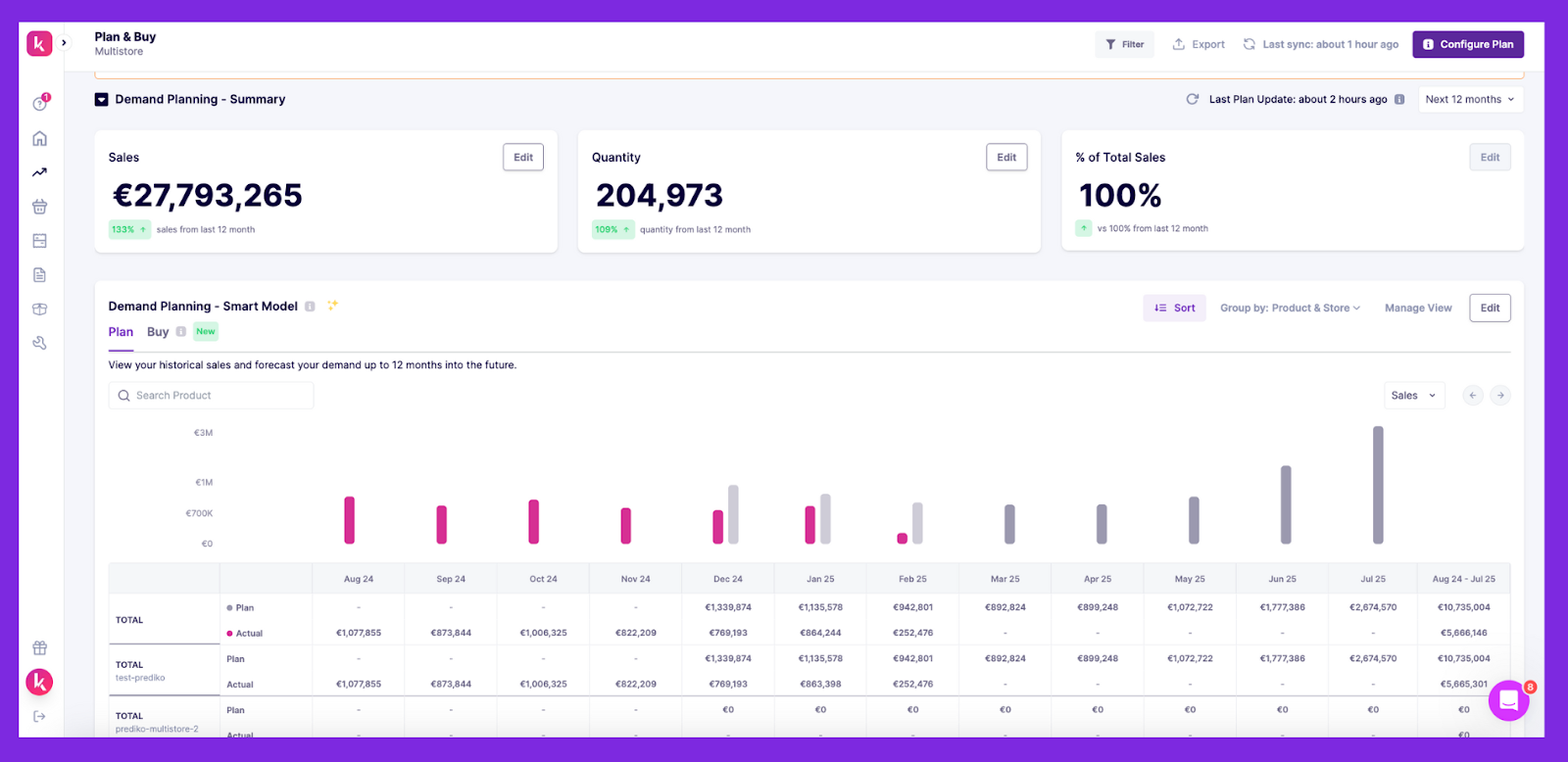
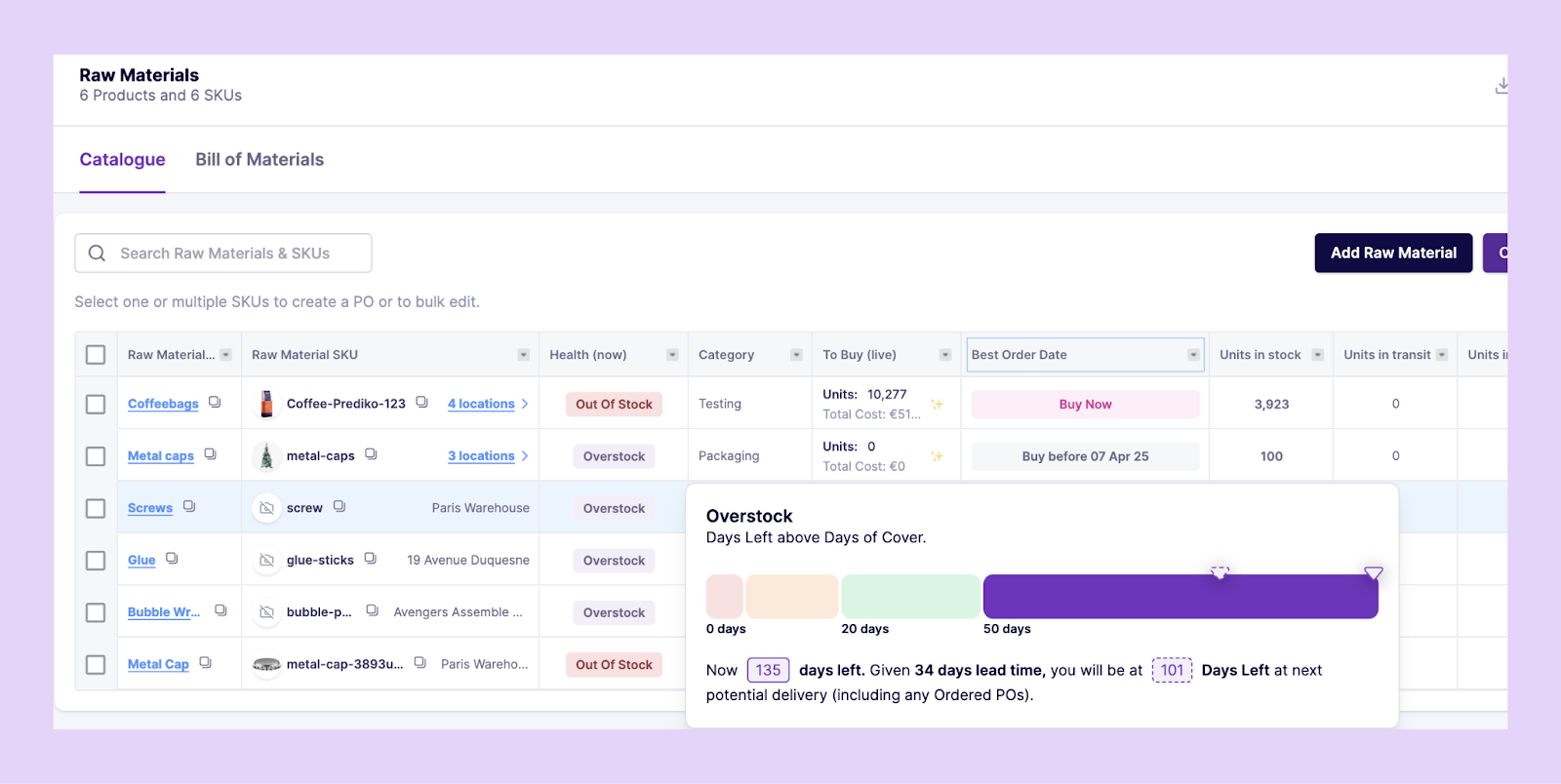


Here’s a step-by-step process on how you can implement AI in your inventory management workflows.
AI implementation starts with clean, connected data. Your sales, inventory, and supplier information need to flow into your inventory management system. This is the foundation for accurate forecasts and recommendations that follow.
Make sure the platform you choose integrates directly with Shopify (or your eCommerce platform of choice). Without structured, real-time data, even the smartest AI won’t deliver reliable results.
Prediko connects natively to your Shopify store and automatically pulls in both historical and real-time data; no manual uploads required.
It fetches all SKUs across locations (including bundles), along with sales, inventory, and supplier data behind the scenes, so setup takes just a few minutes.
Next, clean and standardize your data.
Make sure SKUs are consistent across systems, remove duplicates, and align units of measure.
AI models rely on structured data to make sense of patterns. Poorly formatted data leads to inaccurate forecasts and flawed decision-making.
It’s show time. This is where AI gets to work. At this stage, you’ll forecast how much stock each SKU will need, when, and at which location.
AI predictions go beyond past sales, factoring in supplier lead times, sales velocity, seasonality, and historical growth trends.
Prediko’s well-trained AI generates demand plans based on past sales, seasonality, and growth trends.
You can then layer in your own expertise by editing the AI-generated plan, giving you both accuracy and full control over your inventory strategy.
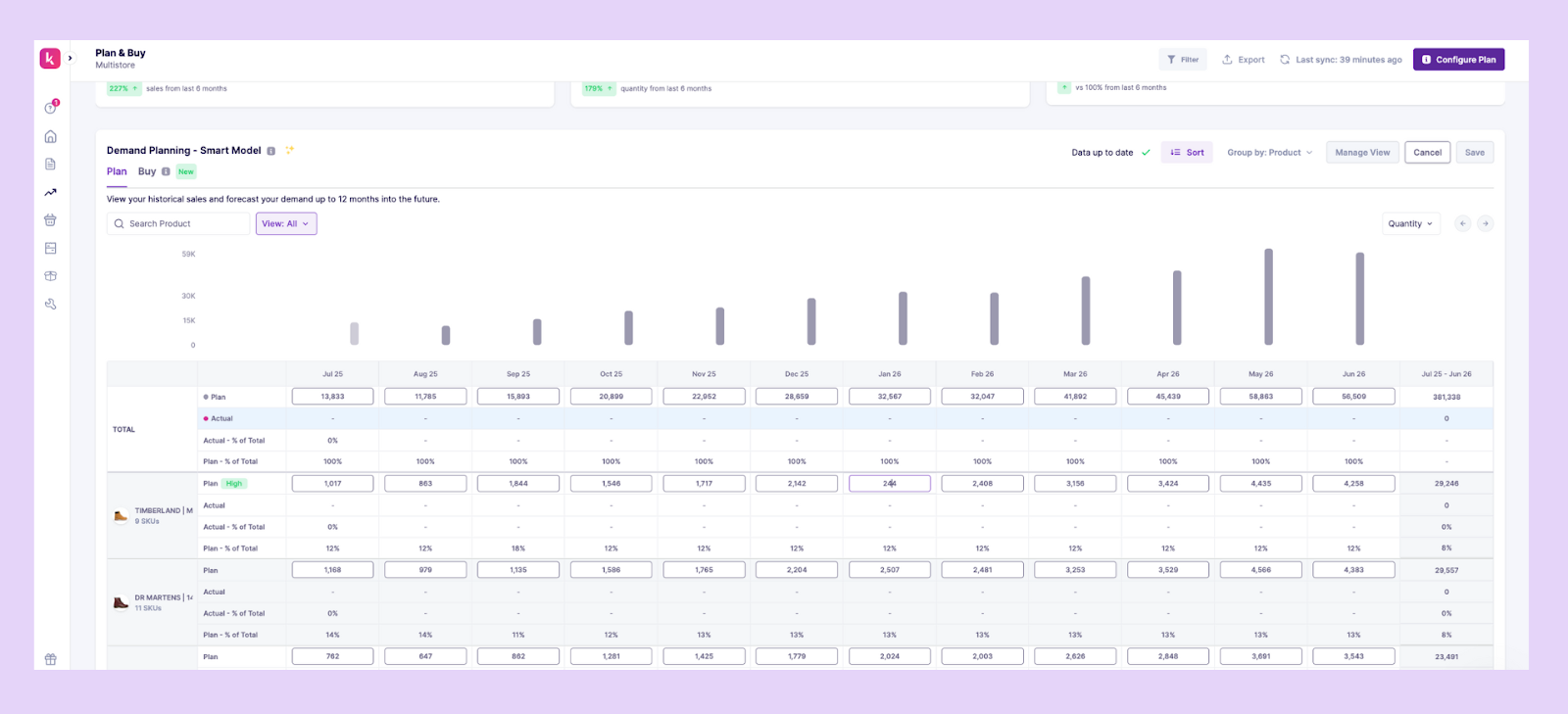
When your forecast is ready, the next step is to act on it. This means knowing which SKUs need to be reordered, how much, and when based on lead times, safety stock, and current stock.
When you use Prediko, its AI automatically generates a smart replenishment plan based on your current stock levels, days of cover, expected demand, incoming orders, and lead times for each SKU.
It also includes a stock health indicator that highlights which products need attention.
You can create and share purchase orders directly from this plan; no exporting or switching tools required.

Once forecasting and purchasing are in place, the next step is tracking how those decisions impact performance.
That means monitoring inventory levels, identifying stockout frequency, and evaluating whether your sales targets are being met.
Prediko offers customizable report templates to track stockouts, at-risk SKUs, dead stock, ABC analysis, sell-through rates, and more.
For a high-level view of performance, the Planning Dashboard shows planned vs. actual sales, so you can easily spot gaps between forecasted and real outcomes.
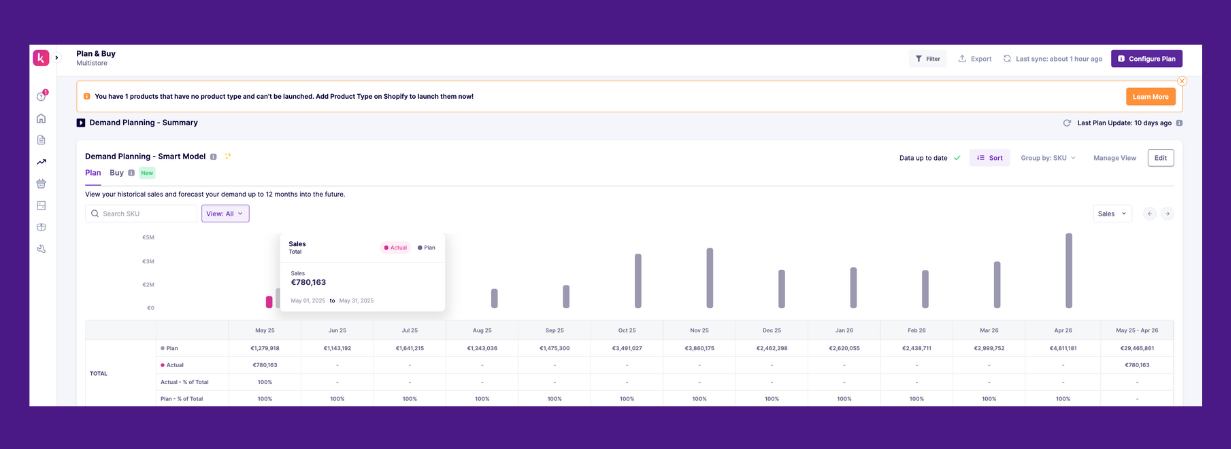
Plus, with automated daily and weekly email reports highlighting upcoming POs and stock risks, you’ll never miss a critical action.
AI sounds great in theory. But in practice? Implementation often comes with its own set of hurdles. Let’s walk you through the most common ones and how to solve them.
AI models are only as reliable as the data they’re built on. If your sales history is patchy, lead times are outdated, or SKUs are inconsistently named, your forecasts will be off, and so will your purchasing decisions.
The key is to ensure clean, structured, and real-time data across your inventory, sales, and supply chain.
Prediko pulls structured data directly from your Shopify store; syncing sales, inventory, purchase orders, and supplier information automatically.
By eliminating manual uploads and inconsistencies, Prediko creates a strong foundation for accurate, AI-powered workflows.
If a tool is too complex or requires extensive training, teams are unlikely to use it consistently.
When introducing AI-based systems, the learning curve should be minimal. Look for tools with intuitive interfaces and actionable outputs.
Start small. Introduce one or two core workflows your team can adopt quickly, then expand from there.
Prediko’s interface is designed to be incredibly intuitive, so easy to use that your team won’t need any training.
This low-friction onboarding makes adoption seamless, builds trust quickly, and helps your team start seeing value from day one.
Connecting multiple systems (eCommerce platform, warehouse, and 3PLs) can stall implementation.
To avoid implementation delays and disconnected workflows, choose software that integrates easily with your existing stack or works with the data you already have.
Prediko integrates natively with Shopify and connects seamlessly with 70+ third-party apps like WMS platforms and 3PLs.
This makes it simple to unify inventory data across systems without needing custom builds or manual syncing.

Forecasts are useful only if they lead to action. One common challenge is when AI tools generate predictions but don’t tell you what to do with them. Teams are left asking what the numbers actually mean for purchasing.
To get real value, AI outputs should be embedded directly into workflows and drive clear next steps.
Prediko turns forecasts into actionable reorder suggestions. Right next to the Planning tab is the Buying Tab that highlights what’s low, what’s at risk, and what needs to be ordered based on your forecast, so you can act on it instantly.
AI outputs don’t sit in isolation, they flow directly into your purchasing decisions.
With dozens of tools claiming to use AI for inventory management, knowing what to look for can save you time, money, and headaches.
Here are four essentials to help you pick a platform that actually moves the needle.
At the heart of any AI inventory tool is its ability to forecast demand.
Look for platforms that use historical sales, seasonality, lead times, and real-time data to generate dynamic forecasts.
Bonus if the system lets you layer in human insights and override plans based on upcoming events or expert judgment.
Even the smartest AI is useless if your team doesn’t use it.
Prioritize tools that are intuitive, require little to no training, and mirror the way your team already thinks about inventory, by SKU, supplier, stock level, and location.
A clean, actionable interface helps with fast adoption and ongoing consistency.
See how easy it is to migrate to Prediko.
Your AI system is only as good as the data it receives. Choose software that connects natively to your storefront (like Shopify), warehouse tools, and 3PLs.
This ensures real-time updates and eliminates the need for manual data entry or custom APIs, saving you hours each week.
Beyond forecasting, strong AI tools should also guide purchasing.
This includes showing you what to reorder, how much, and when, factoring in stock levels, lead times, MOQs, and current demand.
Some platforms, such as Prediko, go a step further and allow you to create and manage purchase orders directly inside the system.
Here’s a quick comparison between Prediko and traditional tools.
Start your 14-day free trial today and see how Prediko’s AI transforms your inventory workflows.
In a world where demand shifts fast and customers expect instant availability, traditional inventory systems simply can’t keep up. That’s why forward-thinking brands aren’t waiting for problems to react; they’re using AI to anticipate them.
AI for inventory management isn’t just about automation. It’s about smarter decision-making.
From forecasting demand with pinpoint accuracy to triggering timely reorders and optimizing stock across multiple locations, AI gives your business the edge to operate leaner, faster, and more profitably.
Prediko’s AI helps you with just this. It gives you the visibility, control, and speed that spreadsheets and siloed systems never could, that too without building anything from scratch.
Healf, a modern health and wellness retailer in the UK, struggled with frequent stockouts and poor inventory visibility, especially during seasonal spikes. Their manual forecasting systems often led to overordering slow-moving SKUs while missing fast-selling ones entirely.
By switching to Prediko’s AI-powered inventory management platform, Healf gained a single source of truth for demand forecasting, inventory tracking, and replenishment. The system analyzed historical sales data, seasonality trends, and channel-specific performance across their Shopify storefront and retail partners.

Significant reduction in stockouts across core product lines Improved cash flow by minimizing overstocking on low-velocity SKUsEnabled automated replenishment planning for high-demand products With AI handling inventory logic, the team could shift their focus from firefighting stockouts to scaling their product lines and marketing efforts.
This case underscores how using AI for inventory management transforms operations from reactive to proactive, especially for DTC and retail-first brands managing complex SKU portfolios
AI uses your sales, inventory, and supplier data to predict future demand and suggest what to reorder, when, and in what quantity. It helps reduce stockouts and overstocks by adjusting to changes in real time.
The best AI systems are those built into tools that match your workflow. For Shopify brands, Prediko is designed specifically for SKU-level and multi-store AI forecasting, purchasing, and raw materials management.
Yes. AI-powered tools like Prediko can track inventory across different Shopify stores and warehouses, giving you one view of stock levels and also helping you plan replenishment by location.
